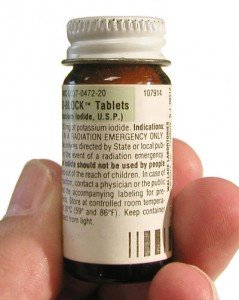Stable Iodine Tablets
Introduction

Radioactive forms of iodine are created in operating nuclear reactors as fission products. Most are short lived so disappear soon after the reactor is shutdown (switched off). Because it is relatively volatile and mobile, iodine is released from nuclear reactor accidents more readily than other less volatile radio-isotopes.
Iodine is an essential nutrient. It naturally concentrates in the thyroid gland in the throat where it is used in the production of hormones that regulate metabolism. Any radioiodine taken in will follow this pathway and deposit a radiation dose in the thyroid. This is known to increase the incidence of thyroid cancer (Ref.)
Stable iodine prophylaxis
(note: A prophylaxis is a measure taken to maintain health and prevent the spread of disease.)

Stable iodine, taken in sufficient doses, can saturate the thyroid gland and reduce the amount of radioactive iodine it absorbs, either from inhaled or ingested iodine, reducing the dose to the thyroid. World Health Organisation guidance on the taking of stable iodine can be found on the internet (Ref.) as can the Government’s (NRPB) (Ref.). This later document suggested that “The priority for emergency planning for stable iodine prophylaxis should be the protection of neonates, children aged under ten years, and pregnant and nursing women” but then recommended against age related ERLs.
The PHE's more recent paper on the protection of the public in a radiation emergency states (Ref.) that " The administration of stable iodine also has few side-effects and is most effective when accompanied by either sheltering-in-place or evacuation, and if administered less than 24 hours prior to, or up to 2 hours after, inhalation of radioiodine released to atmosphere". This paper recommended a reduction in the upper ERL for administration of stable iodine. " This reflects a better understanding of the increased risk of thyroid cancer in young children and of the lower risks of adverse health effects from administration of stable iodine".
Criteria

PHE advice is that protective actions should be applied if the averted dose is greater than the upper Emergency Reference Level (ERL) and not applied if the averted dose is below the Lower ERL. For averted doses between these two values a judgement is needed on the difficulties that imposing the protective action will entail. It is recommended that these levels are applied to the dose integrated out to seven days after the start of exposure. For iodine the lower and upper ERLs recommended are 30 mSv and 100 mSv to the thyroid respectively.
You will be advised when to take your tablets. Do not be tempted to take them before receiving this advice.
Patient Information Leaflet
The Patient Information Leaflet (PIL) (for example (Ref.) is the leaflet included in the pack with a medicine. It is written for patients and gives information about taking or using a medicine. It is important to read this information carefully and follow the instructions closely.